Story by Emmjay
The fact that Indonesia has a multitude – literally thousands – of inhabited islands in the archipelago is often lost on we of the big island. And I’m betting that by extension we fail to recognise Indonesia as the great seafaring nation that she is. Our media seem to suggest that our maritime neighbour is characterised by unsavory people smugglers trafficking death and misery in rotten leaky sinkers.
The truth is that brave Indonesian (often Sulawesi) sailors have been plying a vigorous trade amongst islands in their archipelago and throughout south east Asia since well before the Indian hindus, then their Moghul conquerors, followed by the Portuguese, British and Dutch muscled in.
And like the fleets of the ancient Mediterranean, the Indonesian ships were – and still are – crafted from the iron wood trees of rapidly disappearing forests. Indonesian flagged ships come in all shapes and sizes, but the fleet of island trading wooden ships and boats these days come in two main forms. One is a variation on the Chinese Junk – efficient, spacious and with a low draft (but you’d be struggling to suggest the cargo versions have beautiful lines) and the other – in this story – is about a stalwart of their island trade – the Pinisiq.
Perhaps you might like to have a birds-eye view of one of Tony Abbott and Scott Morrison’s soon-to-be purchases.
This one carries mainly bagged cement and is loaded by 8 sinewy crewmen who weigh only a few kilos more than the bags of cement they stack in the hold.
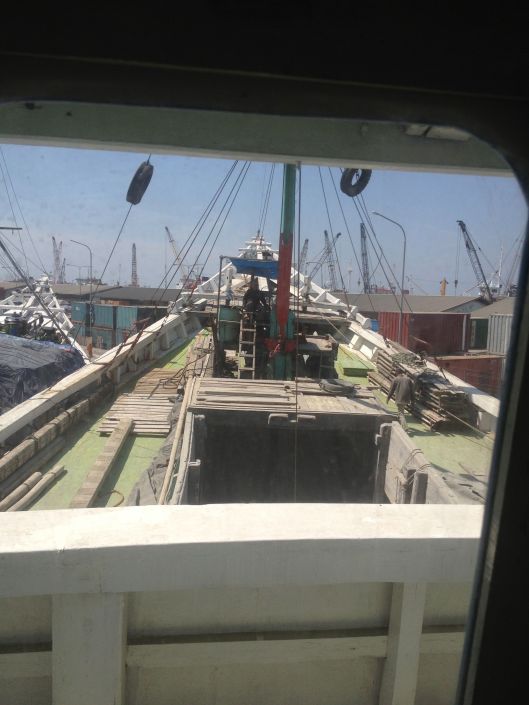
Unbelievably harsh conditions – heat and dust and hard work stacking cement bags in the hold – view from the wheelhouse

Our host – the big wheel is a relic of the sailing past – the tiny wheel to the right steers the now diesel- powered boat.
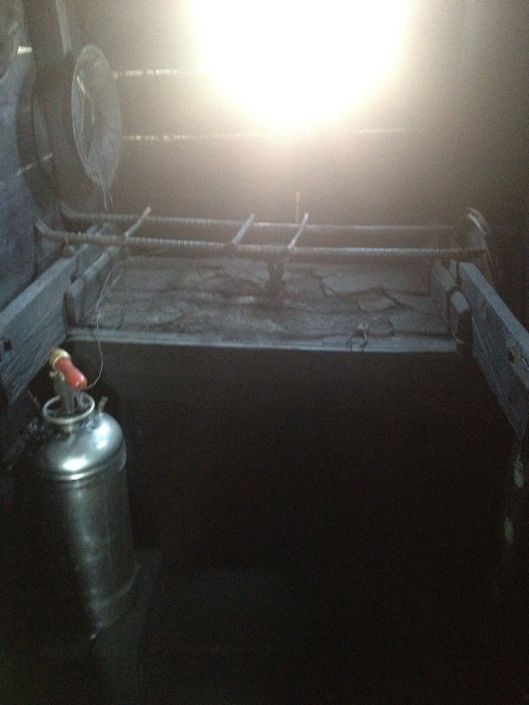
The galley. Serving a ships complement of nine. There was another badly fire damaged Pinisiq being repaired further along the quay. The propane cylinder had exploded and killed the cook. The crew went hungry for a week and the boat has been unseaworthy for a month after limping back to Jakarta.
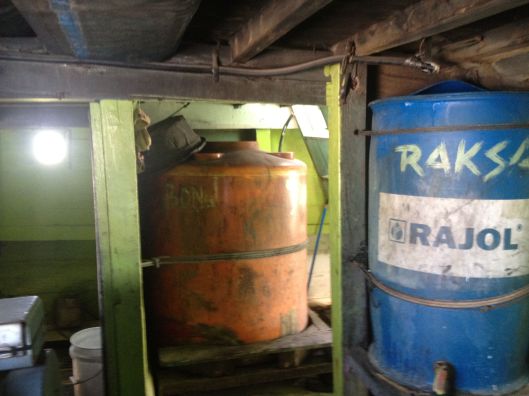
The “fresh” water supply – filled from a hose when in port. When at sea, the sailors rely on rainwater collected from the roof and channelled into these poly tanks.
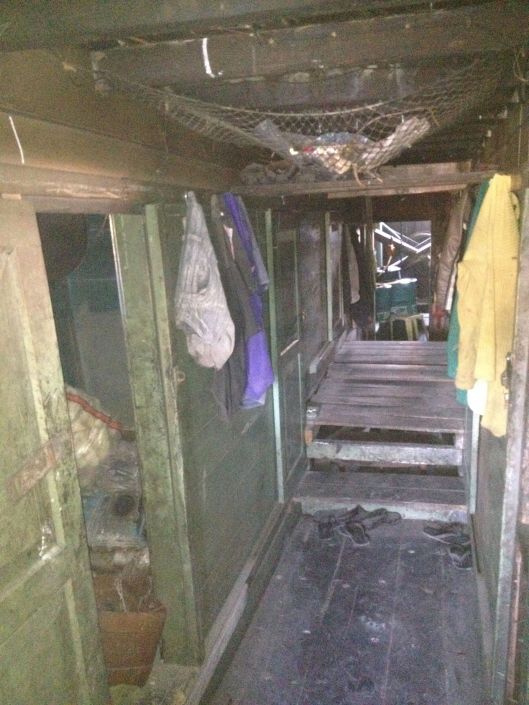
Crew’s sleeping quarters. This was pitch dark – in the middle of the day and the camera insisted on using its flash to get the shot. Note the cement dust everywhere.
I asked our host how much one of these boats might cost Tony and Scott (Ship Chandlers to the Asylum-seeker Classes)- and the answer was “About 5 billion rupiah (about A$500,000). The boat is totally hand-made and plying its trade through the archipelago feeds up to nine families of hard working sailors.
Considering this boat is a lot bigger than the fishing boats that come to Christmas Island – carrying scores of people for days on end, imagine carrying five or ten times the number of people. Enough water ? No scope for cooked food. Sea sickness and one toilet perched off the portside stern – a sea-going version of the long drop. All on a boat less than half this size.
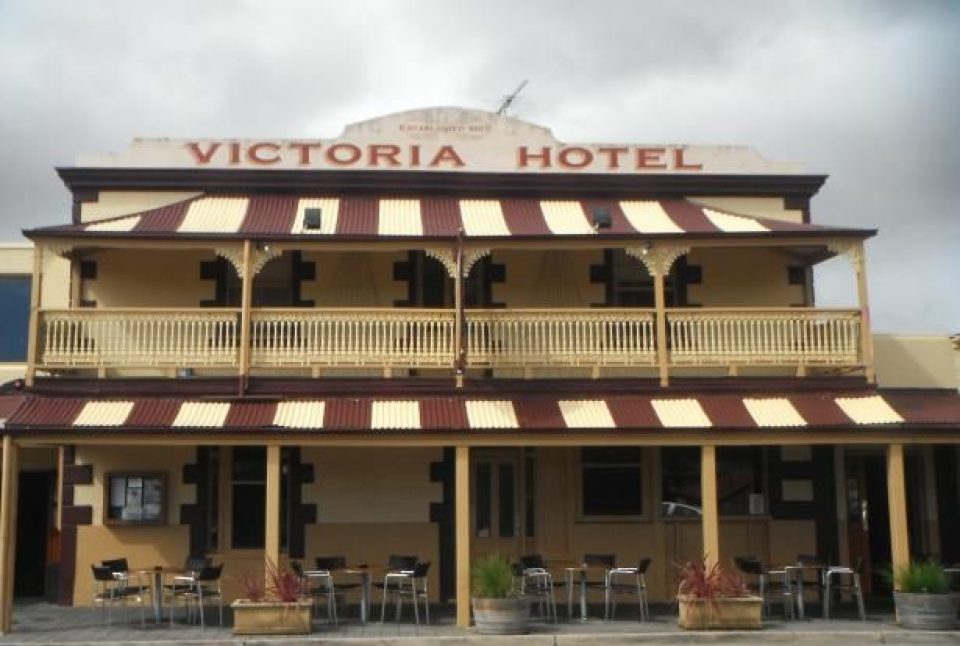
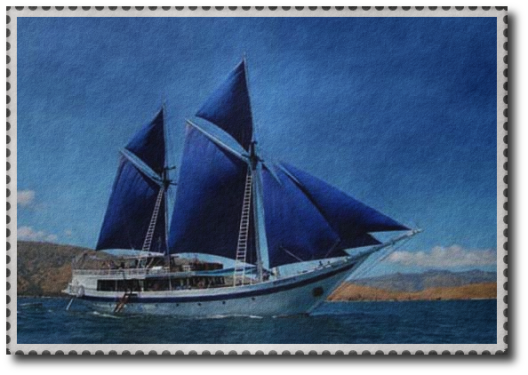
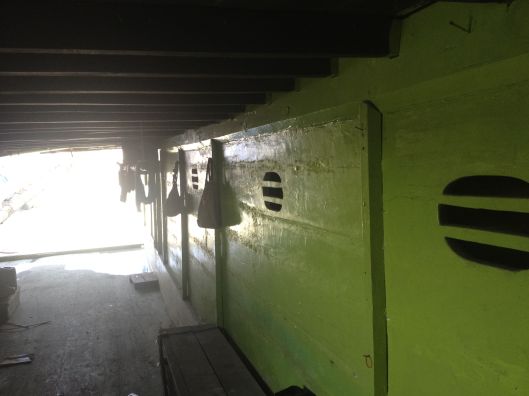
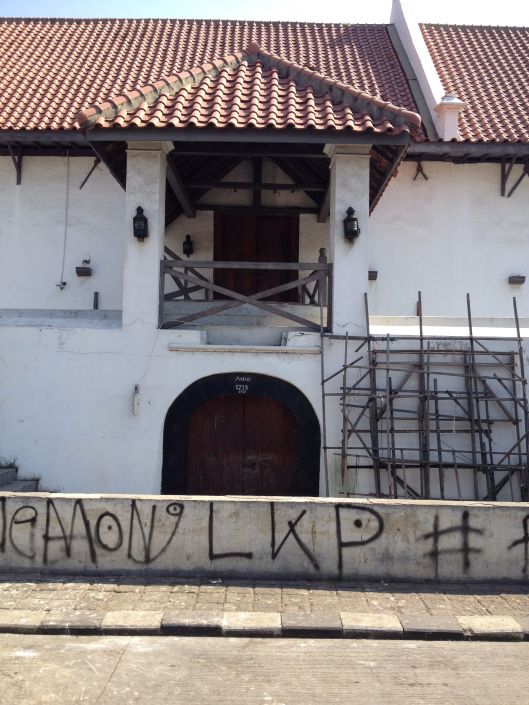
Therese, sure your name is not Maynard B Crebbs? That 1719 building is interesting. Actually the Yolgnu peoples of the NT had complex laws relating to trade with Indonesians (I am the proud owner of a law bag) for hundreds of years.
LikeLike
Well spotted M.(or MMe or Mm) Renard. I couldn’t resist using Maynard G Krebs’ photo. Sadly, Bob Denver passed away in 2005. He was a kind of childhood hero of mine in the early days of TV in Australia. They had such great characters in the Many Loves of Dobie Gillis. These days I admire still Maynard’s shock shrill reaction to the word “Work!”
LikeLike
It was an accident, Gez. One of our team and I went down to the old town and port. When we got there we decided to walk from the old town centre and two locals aid, we ought to turn left and head off that a way. We did and we found a tourist information house that was shut (Saturday afternoon, why not). A freelance guide with a very official looking (not) badge offered to take us on a tour of the port,- for $13 each- through a Pinisiq and in a canoe “out into the open sea” (sounded scary to me – the wind was getting up, but they sensibly just had a peak around a raft of ships that was sheltering us from most of the breeze).
Then we went back to the poorest looking fishing village I have ever seen. The people were kind and friendly. I gave the kids 20,000 rupiah (a fortune – A$2) to jump off the roof of a boat into the water (which they were doing anyway for fun). And then we walked into a wedding -where they offered us a seat and we listened to the live music (belly dancing too) for a while.
Our guide was a well-informed and pleasant chap when I asked him what the fee was again at the end, he said A$15 each – but added that we could always give him a bit more if we wanted to. So we gave him $20 each and thanked him for a great afternoon.
LikeLike
We always found Indonesians to be very helpful and friendly. What struck me that, despite their poverty and hardships they seemed happy. Laughter seemed to be the main sound when walking around. So was playing outdoor chess and of course kite flying by the kids.
The same in Mumbai, India, many, many years ago. One man even said looking up from the pavement where he was sleeping. ‘I am a happy man’. Of course, it is silly to draw much from those scant experiences. Even so, compared with the faces on the London metro. What can one say?
Did you try and speak a few words in Indonesian Emmjay?
LikeLike
I think smiling and laughing just comes naturally to some people in some countries.
LikeLike
Well, it is a dilemma. I mean once we’ve saved $1.3billion (projected over 4 years), by not getting the illegal boats (Fact check ABC), we’ve got all this dosh floating around.
Well, what do we do with it? I dunno, however $20m, is earmarked for unbribing locals and stirring up the sheep, with stories of vessel purchase.
Let’s say that ¾ of the $20m, will be spent on unbribing and entertainment, that only leaves $5million for boats.
Personally I think that a few ex-cement ships would have been a dandy addition to Rudd’s new Qld navy. However according to my arithmetic we’ll only be able to buy 10? And then there’s the fit out – with union laboru blowing the cost out to one zillion each.
Oh well, I’ll just concentrate on creating jobs; the real key paying for stuff.
Just some other stuff: I keep thinking of Vivien’s answer to prosperity in Australia, when she proposed more tax:
A snip of ideas:
Business Council of Australia chief executive Jennifer Westacott said the OECD finding endorsed the council’s call for a more competitive tax system. “Given Australia’s over-reliance on company tax, it is not surprising that the OECD found that we’ve experienced the largest fall in tax revenue as a share of GDP in the five-year period following the GFC,” she said.
The OECD research shows that Australia’s tax revenue has fallen by four percentage points of GDP following the onset of the global financial crisis, against an average fall across the advanced world of only 1.2 percentage points. At its peak before the crisis, company tax was delivering 17.8 per cent of government revenue compared with an OECD average of 11.3 per cent, but this had fallen to 14.6 per cent.
The study says company taxes are particularly sensitive to the economic cycle.
About half of advanced countries have lowered their company tax rates since the GFC despite the pressure on their budgets. The study said the financial crisis had reduced business investment in almost all OECD countries. Australia was an exception because of the resources boom, but investment in non-resource industries had been very weak. “A recovery in business investment is widely seen as critical for restoring economic growth,” the study said.
Although tax is not the most important determinant of investment, research shows it responds positively to rate cuts. While Australia’s company tax rate has remained steady at 30 per cent, the average rate among advanced countries has come down from 26.9 per cent to 25.5 per cent. Many countries, including Britain, Denmark and Norway have further company tax cuts planned.
Ms Westacott said Australia’s elevated company tax rate damaged its competitiveness. “Australia needs a tax system able to meet future revenue requirements, while fostering economic growth by ensuring our tax rates and tax bases keep us competitive.”
–
LikeLike
Brilliantly done, Emms!
A magnifying glass over Abbott’s gruesome as well as moronic policies concerning the asylum seekers issue.
There is nothing in his policies that will not backfire, that will achieve anything but the currency that this country’s leaders are a shameful lot of mindless pirates, of fools who turn a civil matter into a military and political one.
This spiral to the hells of brutality, however, in my view has begun with the ALP who launched full-sail into implementing the view that being brutal to someone will make them behave as we see fit.
It has begun by them and it is no surprise that the right wingnuts will take it to its furthest possible extremities; and to keep those brutalities hidden from public scrutiny. I’m not at all surprised by what these mongrels are doing and are willing to do. I WAS, however, very surprised by Labor’s turn of thinking.
Labor got what it deserved and we and the refugees got what neither of us deserve.
LikeLike
I think the Indonesians will tell Abbott and Morrison to p.off/mind their own business.
LikeLike
I hope so, viv.It’s all starting to sound like a title of a nineties movie Secrets and Lies. 🙂
LikeLike
I think your right vivenne, I wouldn’t be surprised if SBY turns his back.
LikeLike
Not completely though. He’d probably keep his palm up.
He’s got commitments in Chelsea after all. Not a mortgage, but the rates and housekeeping staff.
LikeLike
Viv they have said some surprisingly blunt things already to that effect. In general I found the officials with whom we spoke, to be extremely courteous and kind and they go always out of their way to avoid what our officials euphemistically refer to as a “robust discussion”.
I think that Indonesians will do what is referred to on the Urban Dictionary web site as a “California no”. Nobody ever say “no” – one is supposed to take the hint when they say “lets do lunch sometime” – meaning never.
LikeLike
Exactly.
LikeLike
Jam karat could well apply here too.
LikeLike
There is no really concise word for ‘no’ in Indonesian language. They will most likely refer to ‘I am not sure’ or “I don’t know” or even better, ‘perhaps’, leaving both options open. The one thing they don’t want to do is to hurt feelings.
I sometimes think some of us on the P/A could do with a bit of that Indonesian sensitivity and resist riling and bullying others. Perhaps that is just a genetic gene and not much can be done about.
You can just imagine how Scott Morrison gets across to the Indonesians or C .Pyne for that matter?
LikeLike
The Batavia Maritime Museum picture makes me think of all the those very ‘cosy’ Dutch style buildings in Yogyakarta, and when the locals found out that gez was Dutch, the older ones were keen to practise their rusty Dutch; the Indonesians were always keen to find out where you came from, were you married and how many children you had. My comfy Eco sandals made them think I was German.
LikeLike
Good to be reminded that there are other civilisations out there with long and occasionally illustrious pasts, particularly our near neighbour. (When I say occasionally, we tend to be unaware that our own basically transplanted European society has not always been illustrious either.)
When you say “Chinese junk” it carries me back to childhood reading of Missee Lee, one of the Swallows and Amazons books. I recall from the book that traditional Chinese junks cannot sail into the wind. Their sailing technology froze for a very long time.
LikeLike
Do you support the decision to restrict the reporting of asylum seeker boat arrivals?
No 82%
Yes 16%
Unsure 1%
1951 votes counted
ABC, The Drum
Pleased to see that people are NOT in favour of Abbott’s Secrecy policy…
LikeLike
I see the SMH ran a similar poll.
Poll: Should real-time updates of asylum seeker boat arrivals continue to be made publicly available?
Yes 84%
No 16%
Total votes: 8792
LikeLike
Very useful you loaded these results helvi, thank you. I seem to have missed out on a lot of reading and only now catching up on this wonderful article by Emmjay too.
LikeLike
That’s an excellent post finally giving a real picture of the hardship of many of Indonesia’s people. I am curious Emmjay what made you go and do the investigation about boat people from the other perspective?
Did you hear the disparaging comment from some old footage when Abbott talked about the detention centre somewhere near Adelaide.
‘We don’t want detention centre picture postcard pictures” to be sent back giving the wrong impression. He was clearly upset that a detention centre had a more normal humane look about them. The locals originally protested against refugees being settled there but after a couple of years, changed their minds and now resent the centre from being closed.
How could this society ever have voted such a heartless man into power.?
With the clamp-down on information about asylum seekers we are eerily getting to pre-war Germany when information about the ”settlement of Jews” was also kept out of sight and public scrutiny.
LikeLike
I reckon the Detention Centre you meant here is Baxter that is the same featured in my article here on the Pigs Arms, Gez.
LikeLike